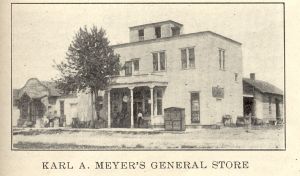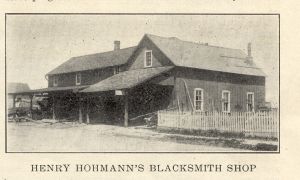|
Page 51 |
|
|
Hoffman is located eight miles west of Centralia and four miles east of Posey. It is an unincorporated village and has several business houses and one large creamery which does a large business annually. Hoffman has a population of more than 100 inhabitants and for a small village is one of the best in the eastern part of the county. It has two large general stores, two blacksmiths, one lumber yard and elevator, one creamery, one saloon and hotel, and several smaller business houses including blacksmith shops and implement dealers. The business men are progressive and up-to-date. Among the leaders are: Karl A. MEYER The above conducts the largest general store in the village and has been doing business in the city for the past 15 years. He started in 1898, after carefully looking over the ground for a good location, and ever since has had the best patronage in the town. He carries a general line of merchandise and occupies the third building that was erected in the village. Mr. MEYER is also postmaster of Hoffman having filled that office successfully for the past eight years, succeeding August MOEHLMANN. He is also agent for the Southern railway and has been connected with the road for 12 years. Hoffman is not a telegraph station, therefore the duties of agent are light; Mr. MEYER being rather aged can handle the business to the entire satisfaction of the company. He was born
in St. Louis in 1848 and has lived in Hoffman since 1881. He was married in 1876 to Mary KULMS and raised six children: one of them died a few years ago. He has one boy and four girls living at present. The son assists his father in the store and one of the girls is a trained nurse, one a stenographer and bookkeeper, one an artist, and one at home. The son, Vincent, manages the store. Henry HOHMANN Henry HOHMANN has been in business in Hoffman for the past four years and sells binders, implements, vehicles and harness and does general blacksmithing and horseshoeing. He handles the P. & O. implements, Peter’s buggies, Lindstrohm and Columbus wagons, and all kinds of harness. He is also a wheelwright and has a very |
large and growing business. For many years previous to locating in Hoffman he was in the same business in Bartelso where he was born in 1881. He attended the schools of Bartelso and Hoffman and was married to Miss Lena LUEKING in 1906. Three children were born to the couple, one of whom is dead. Mr. HOHMANN is one of the most progressive business men in the little city of Hoffman
and his business has been steadily increasing for the past three years. His place of business is the largest of its kind in the city, and he is contemplating on building an addition to his already large business block which is located on the west side of the main street, north of the tracks. WHAT IS THE MOST VALUABLE SCENERY IN ILLINOIS. "Humph," you reply, "Illinois hasn't any scenery." On the contrary we have the finest in the world. It is true that we have no mountains, or even hills in the true geologic sense, and the Mississippi is not so spectacular within our borders as to the north. But the great bulk of our land is prairie, and the prairie is one of the greatest symbols of the infinite to be found on the earth's surface. It seems as infinite as the sea, and far more human now that man has tamed it. The one great characteristic of the American people is their breadth of view, and they get it largely from the prairies. This quality of mind, says Jens Jensen, the landscape gardener, will make the middle west the most powerful and prosperous region in the world, and breed the finest race of men.- Throughout future ages the prairie will silently tend to ingrain this character into the blood and bone of the people who grow out of the richest soil in the world. And Illinois is the "Prairie State." The leading state in wheat production is North Dakota, with an acreage exceeding 8,000,000. Kansas follows with nearly 6,000,000 acres of wheat, and Minnesota and South Dakota, with over 3,000,000 bushels each, follow. The increase in the value of wheat per bushel over that of 1899, when it was $0.56 per bushel is enormous. The average value of the wheat crop per acre more than doubled between 1899 and 1909. |
This file last modified

